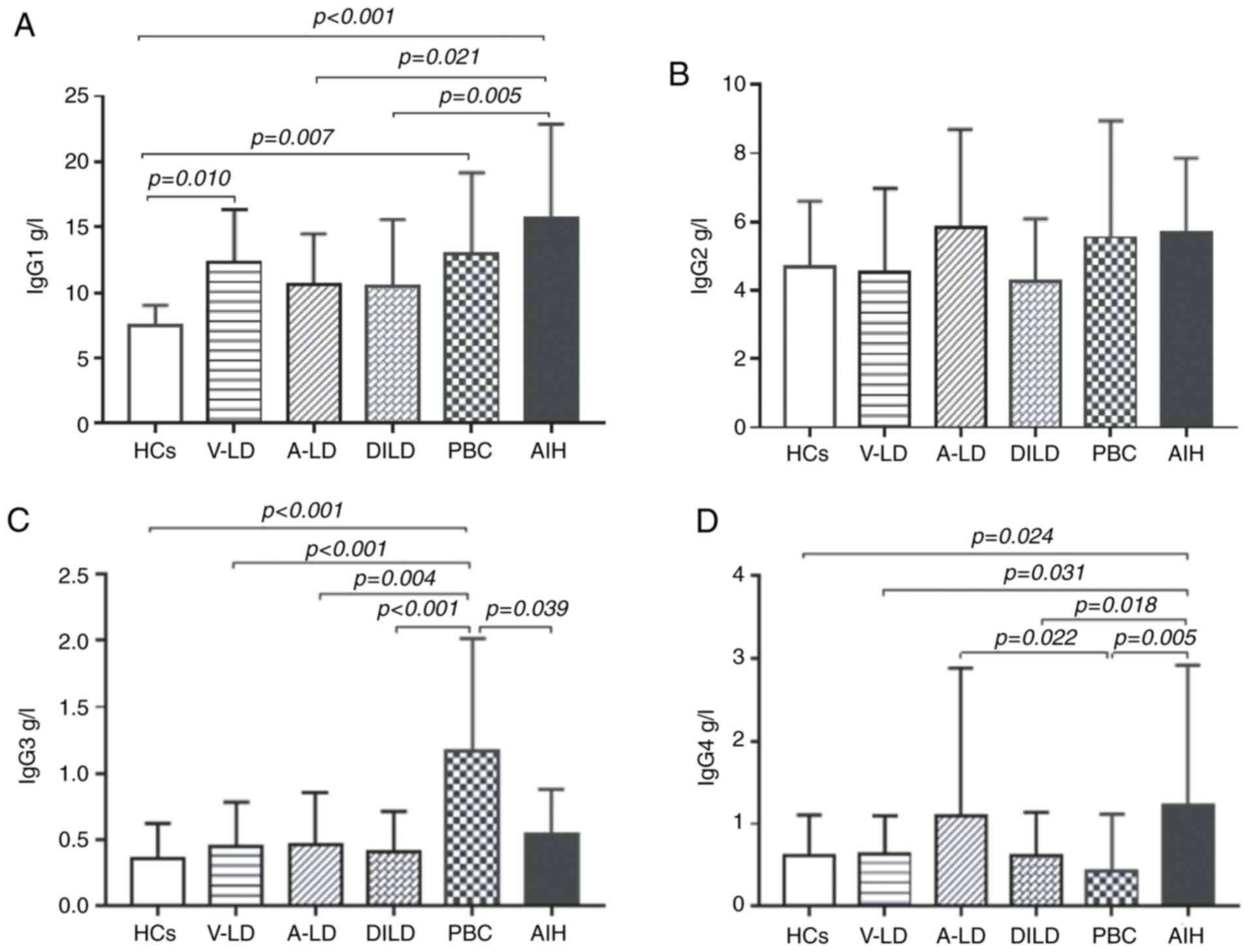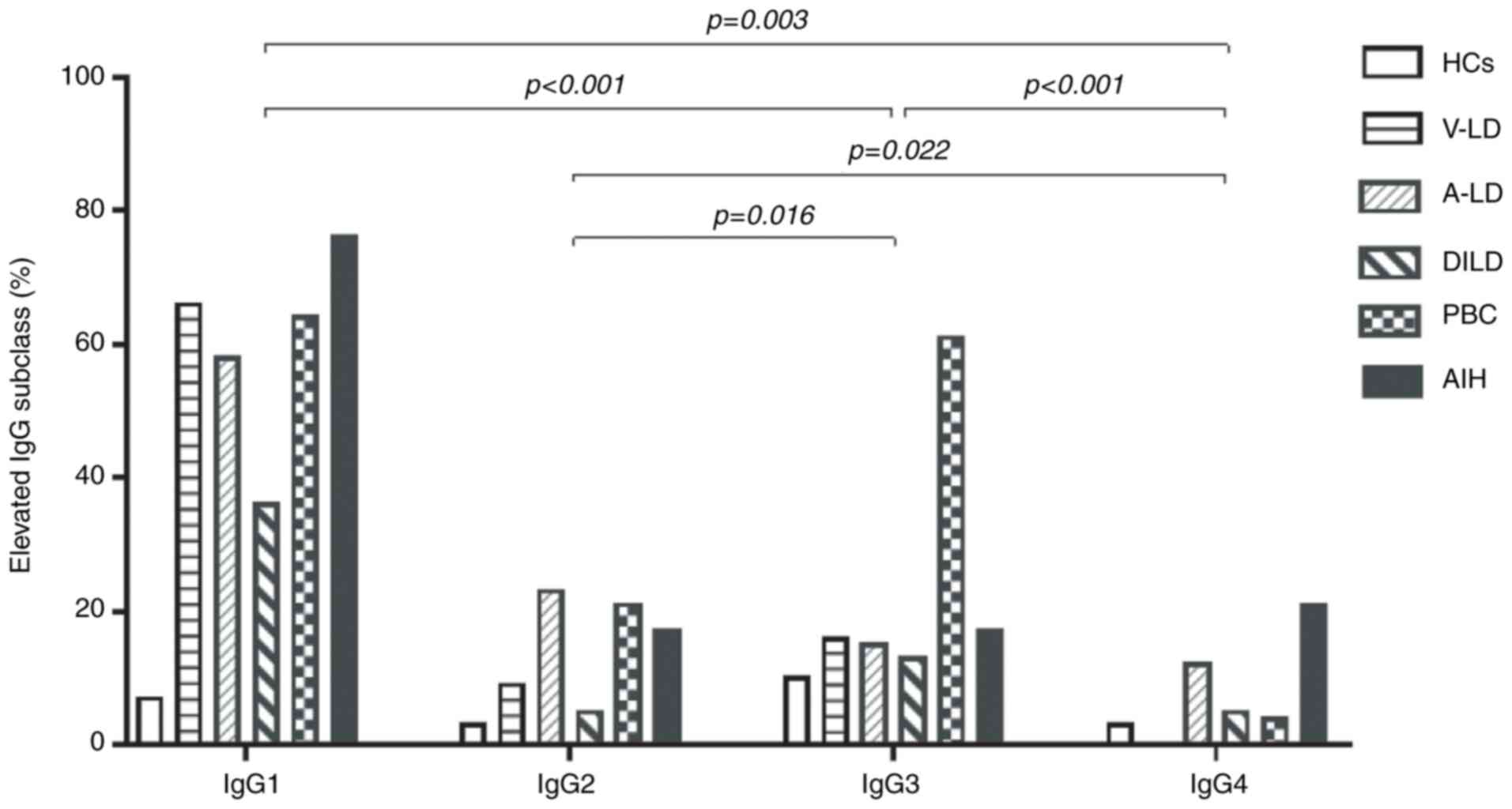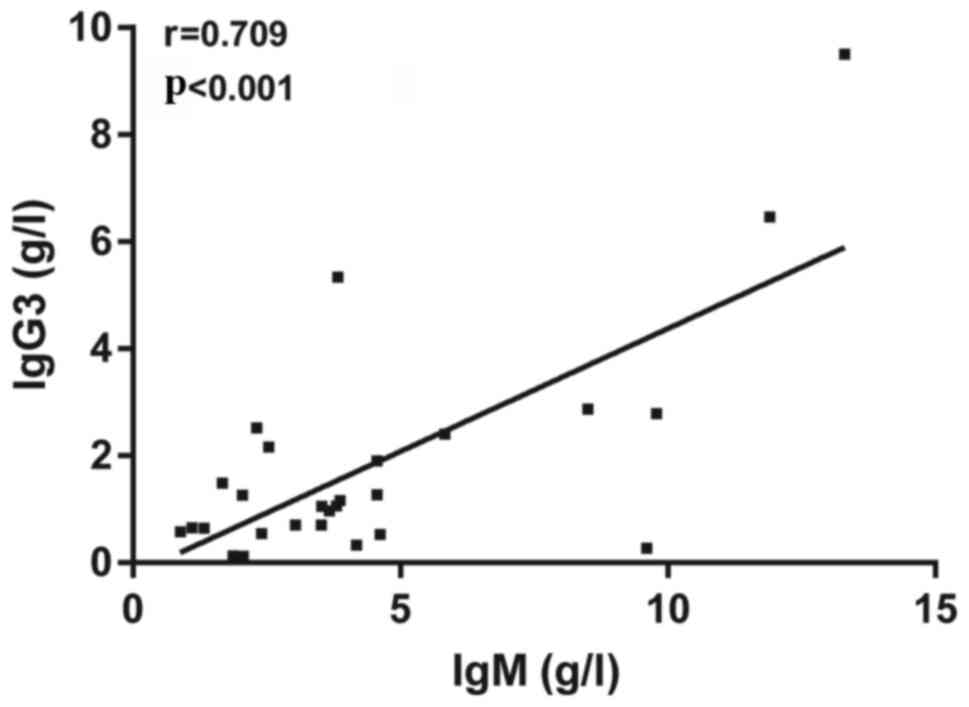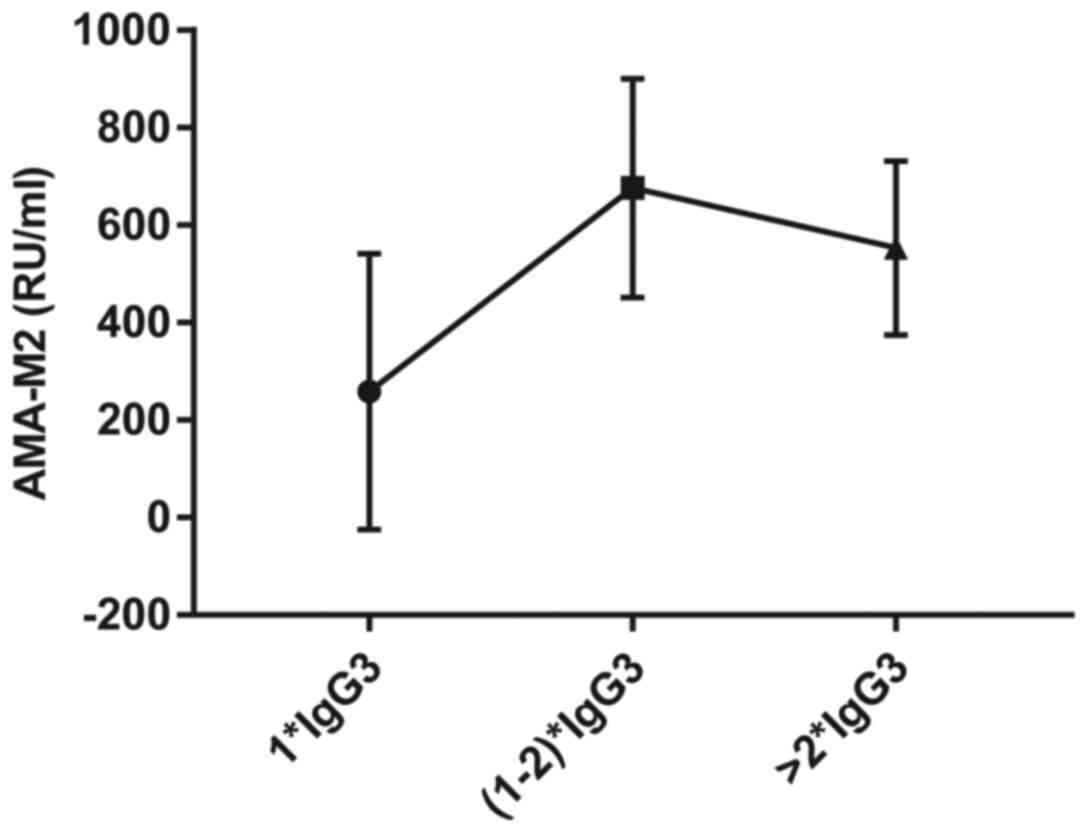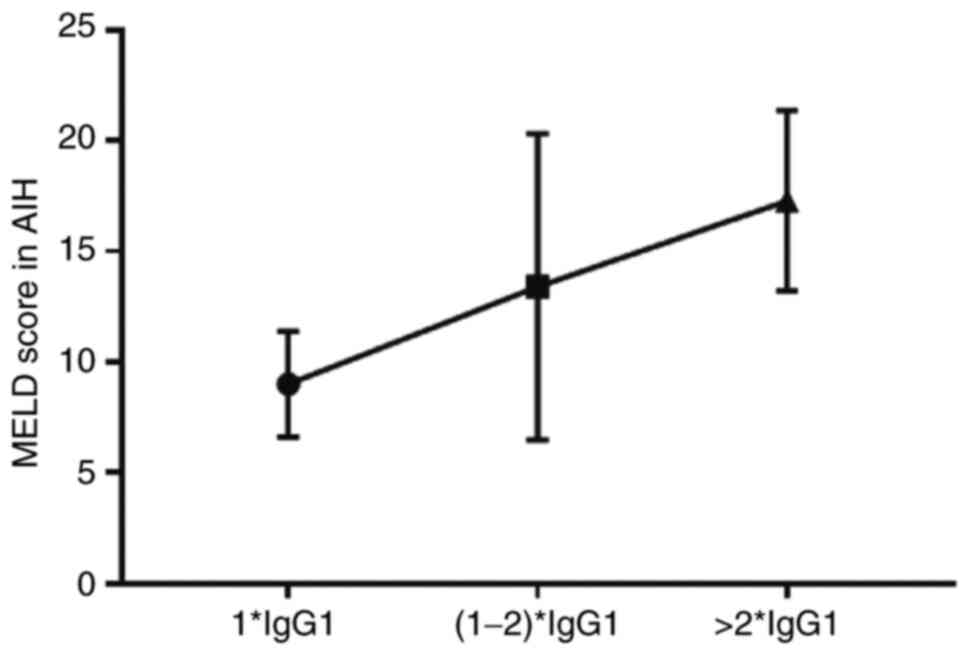|
1
|
Asrani SK, Devarbhavi H, Eaton J and
Kamath PS: Burden of liver diseases in the world. J Hepatol.
70:151–171. 2019.PubMed/NCBI View Article : Google Scholar
|
|
2
|
Rowe IA: Lessons from epidemiology: The
burden of liver disease. Dig Dis. 35:304–309. 2017.PubMed/NCBI View Article : Google Scholar
|
|
3
|
GBD 2013 DALYs and HALE Collaborators.
Murray CJ, Barber RM, Foreman KJ, Abbasoglu Ozgoren A, Abd-Allah F,
Abera SF, Aboyans V, Abraham JP, Abubakar I, et al: Global,
regional, and national disability-adjusted life years (DALYs) for
306 diseases and injuries and healthy life expectancy (HALE) for
188 countries, 1990-2013: Quantifying the epidemiological
transition. Lancet. 386:2145–2191. 2015.PubMed/NCBI View Article : Google Scholar
|
|
4
|
Wang FS, Fan JG, Zhang Z, Gao B and Wang
HY: The global burden of liver disease: The major impact of China.
Hepatology. 60:2099–2108. 2014.PubMed/NCBI View Article : Google Scholar
|
|
5
|
Carbone M and Neuberger JM: Autoimmune
liver disease, autoimmunity and liver transplantation. J Hepatol.
60:210–223. 2014.PubMed/NCBI View Article : Google Scholar
|
|
6
|
Kapsogeorgou EK and Tzioufas AG:
Autoantibodies in autoimmune diseases: Clinical and critical
evaluation. Isr Med Assoc J. 18:519–524. 2016.PubMed/NCBI
|
|
7
|
Dusseaux M, Masse-Ranson G, Darche S,
Ahodantin J, Li Y, Fiquet O, Beaumont E, Moreau P, Riviere L,
Neuveut C, et al: Viral load affects the immune response to HBV in
mice with humanized immune system and liver. Gastroenterology.
153:1647–1661.e9. 2017.PubMed/NCBI View Article : Google Scholar
|
|
8
|
Berry AA, Gottlieb ER, Kouriba B, Diarra
I, Thera MA, Dutta S, Coulibaly D, Ouattara A, Niangaly A, Kone AK,
et al: Immunoglobulin G subclass and antibody avidity responses in
Malian children immunized with Plasmodium falciparum apical
membrane antigen 1 vaccine candidate FMP2.1/AS02A. Malar
J. 18(13)2019.PubMed/NCBI View Article : Google Scholar
|
|
9
|
Vidarsson G, Dekkers G and Rispens T: IgG
subclasses and allotypes: From structure to effector functions.
Front Immunol. 5(520)2014.PubMed/NCBI View Article : Google Scholar
|
|
10
|
Valenzuela NM and Schaub S: The Biology of
IgG subclasses and their clinical relevance to transplantation.
Transplantation. 102 (Suppl 1):S7–S13. 2018.PubMed/NCBI View Article : Google Scholar
|
|
11
|
Jansen A, Mandić AD, Bennek E, Frehn L,
Verdier J, Tebrügge I, Lutz H, Streetz K, Trautwein C and Sellge G:
Anti-food and anti-microbial IgG subclass antibodies in
inflammatory bowel disease. Scand J Gastroenterol. 51:1453–1461.
2016.PubMed/NCBI View Article : Google Scholar
|
|
12
|
Khokar A and Gupta S: Clinical and
immunological features of 78 adult patients with primary selective
IgG subclass deficiencies. Arch Immunol Ther Exp (Warsz).
67:325–334. 2019.PubMed/NCBI View Article : Google Scholar
|
|
13
|
Shen H, Zhang M, Kaita K, Minuk GY, Rempel
J and Gong Y: Expression of Fc fragment receptors of immunoglobulin
G (FcγRs) in rat hepatic stellate cells. Dig Dis Sci. 50:181–187.
2005.PubMed/NCBI View Article : Google Scholar
|
|
14
|
Pressler T, Mansa B, Pedersen SS, Espersen
F, Høiby N and Koch C: Methodologic problems in establishing normal
values for IgG subclass concentrations in a pediatric population;
comparison of radial immunodiffusion and ELISA methods. Allergy.
49:772–777. 1994.PubMed/NCBI View Article : Google Scholar
|
|
15
|
van der Gugten G, DeMarco ML, Chen LYC,
Chin A, Carruthers M, Holmes DT and Mattman A: Resolution of
spurious immunonephelometric IgG subclass measurement discrepancies
by LC-MS/MS. Clin Chem. 64:735–742. 2018.PubMed/NCBI View Article : Google Scholar
|
|
16
|
Brito-Zeron P, Ramos-Casals M, Bosch X and
Stone JH: The clinical spectrum of IgG4-related disease. Autoimmun
Rev. 13:1203–1210. 2014.PubMed/NCBI View Article : Google Scholar
|
|
17
|
Okazaki K and Umehara H: Current concept
of IgG4-related disease. Curr Top Microbiol Immunol. 401:1–17.
2017.PubMed/NCBI View Article : Google Scholar
|
|
18
|
Khosroshahi A, Wallace ZS, Crowe JL,
Akamizu T, Azumi A, Carruthers MN, Chari ST, Della-Torre E,
Frulloni L, Goto H, et al: International consensus guidance
statement on the management and treatment of IgG4-related disease.
Arthritis Rheumatol. 67:1688–1699. 2015.PubMed/NCBI View Article : Google Scholar
|
|
19
|
Brito-Zerón P, Bosch X, Ramos-Casals M and
Stone JH: IgG4-related disease: Advances in the diagnosis and
treatment. Best Pract Res Clin Rheumatol. 30:261–278.
2016.PubMed/NCBI View Article : Google Scholar
|
|
20
|
Kamisawa T, Zen Y, Pillai S and Stone JH:
IgG4-related disease. Lancet. 385:1460–1471. 2015.PubMed/NCBI View Article : Google Scholar
|
|
21
|
Culver EL and Chapman RW: IgG4-related
hepatobiliary disease: An overview. Nat Rev Gastroenterol Hepatol.
13:601–612. 2016.PubMed/NCBI View Article : Google Scholar
|
|
22
|
Westra J, van Assen S, Wilting KR, Land J,
Horst G, de Haan A and Bijl M: Rituximab impairs immunoglobulin
(Ig)M and IgG (subclass) responses after influenza vaccination in
rheumatoid arthritis patients. Clin Exp Immunol. 178:40–47.
2014.PubMed/NCBI View Article : Google Scholar
|
|
23
|
Huang CC, Lehman A, Albawardi A, Satoskar
A, Brodsky S, Nadasdy G, Hebert L, Rovin B and Nadasdy T: IgG
subclass staining in renal biopsies with membranous
glomerulonephritis indicates subclass switch during disease
progression. Mod Pathol. 26:799–805. 2013.PubMed/NCBI View Article : Google Scholar
|
|
24
|
Sadanand S, Das J, Chung AW, Schoen MK,
Lane S, Suscovich TJ, Streeck H, Smith DM, Little SJ, Lauffenburger
DA, et al: Temporal variation in HIV-specific IgG subclass
antibodies during acute infection differentiates spontaneous
controllers from chronic progressors. AIDS. 32:443–450.
2018.PubMed/NCBI View Article : Google Scholar
|
|
25
|
Zhang YL, Wang ZF and Chen N: Expression
of serum IgG4 in patients with different diseases. Beijing Da Xue
Xue Bao Yi Xue Ban. 49:961–964. 2017.PubMed/NCBI(In Chinese).
|
|
26
|
Zuo Y, Evangelista F, Culton D, Guilabert
A, Lin L, Li N, Diaz L and Liu Z: IgG4 autoantibodies are
inhibitory in the autoimmune disease bullous pemphigoid. J
Autoimmun. 73:111–119. 2016.PubMed/NCBI View Article : Google Scholar
|
|
27
|
Liu Y and Li J: Preferentially
immunoglobulin (IgG) subclasses production in primary Sjogren's
syndrome patients. Clin Chem Lab Med. 50:345–349. 2011.PubMed/NCBI View Article : Google Scholar
|
|
28
|
Yamamoto M, Tabeya T, Naishiro Y, Yajima
H, Ishigami K, Shimizu Y, Obara M, Suzuki C, Yamashita K, Yamamoto
H, et al: Value of serum IgG4 in the diagnosis of IgG4-related
disease and in differentiation from rheumatic diseases and other
diseases. Mod Rheumatol. 22:419–425. 2012.PubMed/NCBI View Article : Google Scholar
|
|
29
|
Chinese Society of Hepatology, Chinese
Medical Association; Chinese Society of Infectious Diseases,
Chinese Medical Association. Hou JL and Lai W: The guideline of
prevention and treatment for chronic hepatitis B: A 2015 update.
Zhonghua Gan Zang Bing Za Zhi. 23:888–905. 2015.PubMed/NCBI View Article : Google Scholar : (In Chinese).
|
|
30
|
Chinese Society of Hepatology, Chinese
Medical Association; Wei L; Chinese Society of Infectious Diseases,
Chinese Medical Association and Hou JL. The guideline of prevention
and treatment for hepatitis C: A 2015 update. Zhonghua Gan Zang
Bing Za Zhi. 23:906–923. 2015.PubMed/NCBI View Article : Google Scholar : (In Chinese).
|
|
31
|
O'Shea RS, Dasarathy S and McCullough AJ:
Alcoholic liver disease. Am J Gastroenterol. 105:14–32.
2010.PubMed/NCBI View Article : Google Scholar
|
|
32
|
Danan G and Teschke R: Roussel Uclaf
causality assessment method for drug-induced liver injury: Present
and future. Front Pharmacol. 10(853)2019.PubMed/NCBI View Article : Google Scholar
|
|
33
|
Lindor KD, Bowlus CL, Boyer J, Levy C and
Mayo M: Primary biliary cholangitis: 2018 practice guidance from
the american association for the study of liver diseases.
Hepatology. 69:394–419. 2019.PubMed/NCBI View Article : Google Scholar
|
|
34
|
Chinese Society of Hepatology, Chinese
Society of Gastroenterology & Chinese Society of Infectious
Diseases. Chinese consensus on the diagnosis and management of
autoimmune hepatitis (2015). J Dig Dis. 18:247–264. 2017.PubMed/NCBI View Article : Google Scholar
|
|
35
|
Kim S, Zerillo J, Tabrizian P, Wax D, Lin
HM, Evans A, Florman S and DeMaria S Jr: Postoperative meld-lactate
and isolated lactate values as outcome predictors following
orthotopic liver transplantation. Shock. 48:36–42. 2017.PubMed/NCBI View Article : Google Scholar
|
|
36
|
Fisher K, Vuppalanchi R and Saxena R:
Drug-induced liver injury. Arch Pathol Lab Med. 139:876–887.
2015.PubMed/NCBI View Article : Google Scholar
|
|
37
|
Kleiner DE, Chalasani NP, Lee WM, Fontana
RJ, Bonkovsky HL, Watkins PB, Hayashi PH, Davern TJ, Navarro V,
Reddy R, et al: Hepatic histological findings in suspected
drug-induced liver injury: Systematic evaluation and clinical
associations. Hepatology. 59:661–670. 2014.PubMed/NCBI View Article : Google Scholar
|
|
38
|
de Liso F, Matinato C, Ronchi M and
Maiavacca R: The diagnostic accuracy of biomarkers for diagnosis of
primary biliary cholangitis (PBC) in anti-mitochondrial antibody
(AMA)-negative PBC patients: A review of literature. Clin Chem Lab
Med. 56:25–31. 2017.PubMed/NCBI View Article : Google Scholar
|
|
39
|
Huang YQ: Recent advances in the diagnosis
and treatment of primary biliary cholangitis. World J Hepatol.
8:1419–1441. 2016.PubMed/NCBI View Article : Google Scholar
|
|
40
|
Lebray P and Varnous S: Combined heart and
liver transplantation: State of knowledge and outlooks. Clin Res
Hepatol Gastroenterol. 43:123–130. 2019.PubMed/NCBI View Article : Google Scholar
|
|
41
|
Rigopoulou EI, Davies ET, Bogdanos DP,
Liaskos C, Mytilinaiou M, Koukoulis GK, Dalekos GN and Vergani D:
Antimitochondrial antibodies of immunoglobulin G3 subclass are
associated with a more severe disease course in primary biliary
cirrhosis. Liver Int. 27:1226–1231. 2007.PubMed/NCBI View Article : Google Scholar
|
|
42
|
Zhang H, Li P, Wu D, Xu D, Hou Y, Wang Q,
Li M, Li Y, Zeng X, Zhang F and Shi Q: Serum IgG subclasses in
autoimmune diseases. Medicine (Baltimore). 94(e387)2015.PubMed/NCBI View Article : Google Scholar
|
|
43
|
Yu J, Song Y and Tian W: How to select IgG
subclasses in developing anti-tumor therapeutic antibodies. J
Hematol Oncol. 13(45)2020.PubMed/NCBI View Article : Google Scholar
|
|
44
|
Ellebrecht CT, Mukherjee EM, Zheng Q, Choi
EJ, Reddy SG, Mao X and Payne AS: Autoreactive IgG and IgA B cells
evolve through distinct subclass switch pathways in the autoimmune
disease pemphigus vulgaris. Cell Rep. 24:2370–2380. 2018.PubMed/NCBI View Article : Google Scholar
|
|
45
|
Nualnoi T, Kirosingh A, Basallo K, Hau D,
Gates-Hollingsworth MA, Thorkildson P, Crump RB, Reed DE, Pandit S
and AuCoin DP: Immunoglobulin G subclass switching impacts
sensitivity of an immunoassay targeting Francisella tularensis
lipopolysaccharide. PLoS One. 13(e0195308)2018.PubMed/NCBI View Article : Google Scholar
|
|
46
|
Alonso M, Gomez-Rial J, Gude F, Vidal C
and Gonzalez-Quintela A: Influence of experimental alcohol
administration on serum immunoglobulin levels: Contrasting effects
on IgE and other immunoglobulin classes. Int J Immunopathol
Pharmacol. 25:645–655. 2012.PubMed/NCBI View Article : Google Scholar
|
|
47
|
Mathurin P and Bataller R: Trends in the
management and burden of alcoholic liver disease. J Hepatol. 62 (1
Suppl):S38–S46. 2015.PubMed/NCBI View Article : Google Scholar
|
|
48
|
Walker MR, Eltahla AA, Mina MM, Li H,
Lloyd AR and Bull RA: Envelope-specific IgG3 and IgG1 responses are
associated with clearance of acute hepatitis C virus infection.
Viruses. 12(75)2020.PubMed/NCBI View Article : Google Scholar
|
|
49
|
Jin J, Xu H, Wu R, Gao N, Wu N, Li S and
Niu J: Identification of key genes and pathways associated with
different immune statuses of hepatitis B virus infection. J Cell
Mol Med. 23:7474–7489. 2019.PubMed/NCBI View Article : Google Scholar
|
|
50
|
Pone EJ, Zhang J, Mai T, White CA, Li G,
Sakakura JK, Patel PJ, Al-Qahtani A, Zan H, Xu Z and Casali P:
BCR-signalling synergizes with TLR-signalling for induction of AID
and immunoglobulin class-switching through the non-canonical
NF-kappaB pathway. Nat Commun. 3(767)2012.PubMed/NCBI View Article : Google Scholar
|
|
51
|
Giuntini S, Granoff DM, Beernink PT, Ihle
O, Bratlie D and Michaelsen TE: Human IgG1, IgG3, and IgG3
hinge-truncated mutants show different protection capabilities
against meningococci depending on the target antigen and epitope
specificity. Clin Vaccine Immunol. 23:698–706. 2016.PubMed/NCBI View Article : Google Scholar
|
|
52
|
Tang L, Zhong R, He X, Wang W, Liu J, Zhu
Y, Li Y and Hou J: Evidence for the association between
IgG-antimitochondrial antibody and biochemical response to
ursodeoxycholic acid treatment in primary biliary cholangitis. J
Gastroenterol Hepatol. 32:659–666. 2017.PubMed/NCBI View Article : Google Scholar
|
|
53
|
Behairy OG, Behiry EG, El Defrawy MS and
El Adly AN: Diagnostic value of soluble programmed cell death
protein-1 in type-1 autoimmune hepatitis in Egyptian children.
Scand J Clin Lab Invest. 80:59–65. 2020.PubMed/NCBI View Article : Google Scholar
|
|
54
|
Than NN, Ching DK, Hodson J, McDowell P,
Mann J, Gupta R, Salazar E, Ngu JH and Oo YH: Difference in
clinical presentation, immunology profile and treatment response of
type 1 autoimmune hepatitis between United Kingdom and Singapore
patients. Hepatol Int. 10:673–679. 2016.PubMed/NCBI View Article : Google Scholar
|
|
55
|
Nakanuma Y, Ishizu Y, Zen Y, Harada K and
Umemura T: Histopathology of IgG4-related autoimmune hepatitis and
IgG4-related hepatopathy in IgG4-related disease. Semin Liver Dis.
36:229–241. 2016.PubMed/NCBI View Article : Google Scholar
|
|
56
|
Lee HE and Zhang L: Immunoglobulin
G4-related hepatobiliary disease. Semin Diagn Pathol. 36:423–433.
2019.PubMed/NCBI View Article : Google Scholar
|
|
57
|
Ebbo M, Grados A, Bernit E, Vély F,
Boucraut J, Harlé JR, Daniel L and Schleinitz N: Pathologies
associated with serum IgG4 elevation. Int J Rheumatol.
2012(602809)2012.PubMed/NCBI View Article : Google Scholar
|















